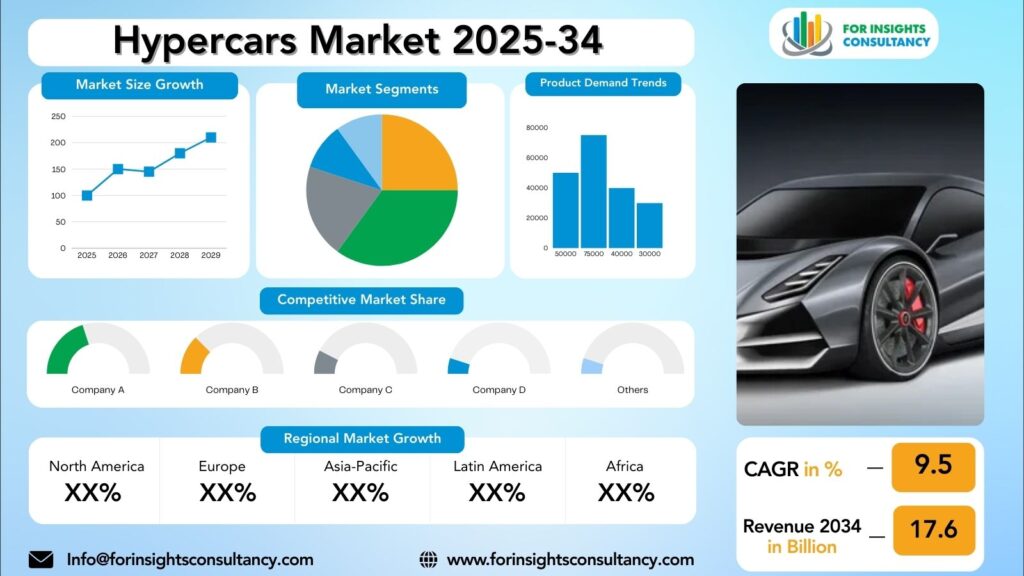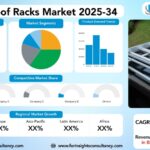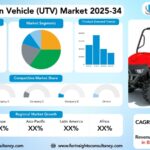
Hypercars Market Research Report by Propulsion/Powertrain (Internal Combustion (IC) Engine, Electric, Hybrid), By Body Type (Convertible, Non-convertible), by Sales Channel (Dealership, Direct-to-Consumer), by End-Use Industry (Racing, Personal Use), and Region Global Market Analysis and Forecast, 2025-2034
Aug-2025 Formats | PDF | Category: Automotive | Delivery: 24 to 72 Hours
Hypercars Market is forecast to increase from USD 8.7 Billion in 2025 to USD 17.6 Billion by 2034, at a CAGR of 9.5%.
Hypercars Market: A Comprehensive Overview and Future Developments
Hypercars, built in limited numbers, offer higher performance and exclusivity than supercars. Brands like Bugatti, McLaren, and Koenigsegg are known for producing iconic hypercars. The future of hypercars promises more exciting innovations, with manufacturers pushing boundaries in speed, performance, and sustainability. Potential future developments include self-driving technology for driver safety, artificial intelligence and machine learning algorithms for optimal performance, and the development of lightweight materials like carbon fiber and graphene for improved aerodynamics and weight reduction.
The hypercars market is experiencing a surge in demand due to limited production runs and unique customization options. Trends include hybrid and electric powertrains, collaboration between luxury car manufacturers and high-end fashion brands, and growing interest from emerging markets in Asia and the Middle East, where wealthy individuals are looking to invest in rare and exotic hypercars.
Hypercars Market Dynamics
Growth Drivers
The hypercars market is driven by technological advancements, such as electric vehicle (EV) technology, artificial intelligence, autonomous driving, and advanced safety systems. Consumer preferences have also shifted, with environmentally conscious consumers seeking high-performance vehicles. The exclusivity and prestige of owning a hypercar have made them highly desirable among affluent buyers. Social media and influencer culture have further popularized hypercars, making them status symbols for the elite.
The hypercars market is characterized by intense competition among leading automakers and boutique manufacturers, with brands like Bugatti, Ferrari, McLaren, and Lamborghini pushing the boundaries of innovation and performance. This competition has resulted in limited-edition models, special editions, and bespoke customization options.
Emerging markets like China, India, and the Middle East have become key growth drivers for the industry, driven by rapid economic development, increasing disposable income, and a burgeoning luxury market. Automakers are investing heavily in developing eco-friendly hypercars, such as hybrid and electric hypercars, which offer high performance without compromising efficiency or sustainability.
Restraints
Hypercars face significant challenges in the market due to high production costs, limited market demand, and regulatory hurdles. The high production costs associated with designing and manufacturing these high-performance vehicles, such as carbon fiber, advanced aerodynamics, and hybrid powertrains, make them prohibitively expensive for many potential buyers. To address this, manufacturers can explore alternative materials and production techniques, leverage economies of scale, and establish strategic partnerships with suppliers.
The market demand for hypercars is relatively limited compared to mainstream cars, appealing to a niche segment of affluent consumers who prioritize performance and prestige. To expand the market, manufacturers can focus on enhancing the driving experience, offering customizable options, and offering personalized experiences.
Regulatory hurdles include stringent regulations and emissions standards imposed by government agencies, which can impact the design and performance of hypercars. Meeting these requirements while maintaining the performance and exclusivity of hypercars can be a daunting task for manufacturers.
Opportunities
The hypercars market is experiencing a surge in demand due to the unique driving experience offered by these vehicles. Manufacturers can capitalize on this demand by producing limited-edition hypercars with bespoke features and unparalleled performance. Technological advancements in automotive engineering are driving innovation in hypercars, pushing the boundaries of speed, performance, and efficiency. By investing in research and development, manufacturers can create faster, more powerful, and environmentally friendly hypercars.
In addition to technological advancements, hypercars are also expanding into emerging markets, such as Asia, the Middle East, and Latin America. By catering to local preferences and tastes, manufacturers can tap into a new customer base and increase global sales and revenue.
Customization and personalization options are key selling points of hypercars, allowing owners to create unique and one-of-a-kind vehicles. Manufacturers can capitalize on this trend by offering a wide range of customization options and personalization services, allowing customers to create their dream hypercar from scratch.
As the automotive industry shifts towards a more sustainable and environmentally conscious future, manufacturers in the hypercars market can lead the way in eco-friendly innovation. By developing hybrid and electric hypercars with reduced emissions and improved fuel efficiency, manufacturers can appeal to environmentally conscious consumers and stay ahead of stringent regulations. Sustainable manufacturing practices, such as using recycled materials and reducing waste, can also help improve brand image and attract environmentally conscious customers.
Challenges
Hypercars are high-end luxury sports cars that are characterized by performance, innovation, and exclusivity. However, the hypercars market faces several challenges.
Staying ahead of evolving market trends and consumer preferences is crucial for manufacturers to create innovative and desirable products. This includes electric powertrains and autonomous driving features.
Balancing performance and sustainability is a challenge as environmental concerns become more prominent. Consumers seek eco-friendly, fuel-efficient vehicles, necessitating the exploration of alternative power sources and lightweight materials. This requires extensive research, development, and testing.
Managing regulatory challenges, such as emissions standards and safety regulations, is a challenge for manufacturers looking to sell their products in global markets. Manufacturers must ensure compliance with a diverse range of requirements to avoid delays and setbacks in production and sales.
Managing supply chain risks and dependencies is essential for a smooth production process and maintaining quality standards. Manufacturers must proactively address potential risks and vulnerabilities to maintain a competitive edge in the hypercars market.
Adapting to technological innovations, such as advanced driver-assistance systems and connectivity features, requires significant investment and expertise. Manufacturers must stay abreast of the latest developments in automotive technology to deliver innovative and futuristic driving experiences that appeal to tech-savvy consumers.
Hypercars Market Top Companies Covered In This Report:
Evaluate The Strategic Positioning And Innovation Pipelines Of Leading Market Companies-From Multinational Enterprises To Disruptive Regional Firms. Understand How Key Players Are Innovating, Expanding, And Capturing Value, And Use Competitive Benchmarks To Plan Your Next Move.
- Ferrari
- McLaren Automotive
- Lotus Cars
- Bugatti
- Porsche
- Koenigsegg Automotive AB
- Aston Martin
- Pagani
- Lamborghini
- Rimac
- Mercedes
- Gordon Murray Automotive
- Zenvo Automotive
- Alfa Romeo
- W Motors
- JLR
- Dendrobium
- Xing Mobility
- Pininfarina
- Aspark
- Ariel
- Tesla
- Hispano Suiza
- Others
Hypercars Market News
Bugatti
In mid-2024, Bugatti unveiled the Tourbillon, the successor to the Chiron. The new hypercar is powered by a naturally aspirated V16 hybrid powertrain, marking a significant technological shift for the brand. The Tourbillon has since been showcased at prestigious events like the Goodwood Festival of Speed and Monterey Car Week.
Koenigsegg
In August 2025, a Koenigsegg Jesko Absolut set a new 0-400-0 km/h (0-250-0 mph) world record for homologated road cars, surpassing its own previous record from June 2024. The new record was made possible by advanced software strategies that the company plans to roll out to customer vehicles, demonstrating a commitment to continuous improvement.
Segmented View of the Industry:
The Hypercars Market Is Mapped Through A Multidimensional Lens-Tracking Shifts Across Product Type, Applications, And Geographic Regions. This Segmented Approach Enables Businesses To Localize Their Growth Plans And Align Offerings With The Most Profitable Demand Centers.
Segmentation by Body Type
- Convertible
- Non-convertible
Segmentation by Propulsion/Powertrain
- Internal Combustion (IC) Engine
- Electric
- Hybrid
Segmentation by Sales Channel
- Dealership
- Direct-to-Consumer
Segmentation by End-Use Industry
- Racing
- Personal Use
Global Geographic Coverage:
The Report Provides In-Depth Qualitative and Quantitative Data On the Hypercars Market For All Of The Regions And Countries Listed Below:
North America
The hypercars market in North America is thriving, with the United States leading the charge with manufacturers like Tesla, Ford, and Chevrolet. The US has a strong economy and a culture that values speed and luxury, leading to the production of cutting-edge hypercars. Tesla, known for its electric vehicles, appeals to environmentally conscious consumers who still crave speed and performance. Canada, despite not being as well-known for its hypercars as the US, is also experiencing growth in the market. Canadian buyers, like American counterparts, appreciate high-performance vehicles, and manufacturers like McLaren and Bugatti have made inroads into the market. With a strong economy and growing interest in luxury automobiles, Canada is poised to become a key player in the hypercars industry.
Europe
Italy, home to iconic hypercar manufacturers like Ferrari, Lamborghini, and Pagani, is renowned for its craftsmanship, cutting-edge technology, and unmatched performance. Italy’s rich automotive heritage and tradition of excellence in engineering contribute to its dominance in the hypercars market. Italian hypercars are considered works of art, combining performance with beauty in a unique way.
Germany, with brands like Porsche, Mercedes-Benz, and Audi, is a key player in the hypercars market, known for precision engineering, advanced technology, and exceptional driving dynamics. German hypercars are also committed to sustainability and eco-friendliness, investing heavily in electric and hybrid technologies.
The United Kingdom, with brands like McLaren and Aston Martin, is also making a name for itself in the hypercars market. British hypercars are characterized by sleek designs, powerful engines, and attention to detail, designed to push the boundaries of speed and performance. The success of British hypercars can be attributed to the country’s passion for motorsports and engineering, as well as its involvement in Formula One and other racing events.
Asia Pacific
The Asia Pacific region is a significant market for hypercars, with China, Japan, and Singapore leading the way. China’s booming economy and high-net-worth individuals have led to significant sales growth for luxury brands like Lamborghini, Ferrari, and Porsche. The Chinese government’s efforts to promote electric vehicles are also driving innovation in the hypercars market. Japan, with its long history of automotive innovation, has iconic brands like Toyota, Honda, and Nissan leading the global market. Japanese hypercar manufacturers like Toyota’s Gazoo Racing and Honda’s NSX have gained a strong following among enthusiasts for their blend of performance and reliability. Singapore, despite its small size, has a significant presence in the hypercars market due to its wealthy city-state and thriving automotive community. Brands like McLaren and Aston Martin find niche markets among affluent residents.
Middle East and Africa
The Middle East and Africa are experiencing a booming hypercar market, with countries like the United Arab Emirates, Saudi Arabia, and Qatar becoming hotspots for hypercar manufacturers. Luxury car enthusiasts are showing strong demand for the latest models, with brands like Bugatti, Ferrari, and Lamborghini seeing strong demand in the Middle East. In contrast, the African market is experiencing a growing interest in high-performance vehicles, with countries like South Africa, Nigeria, and Kenya seeing an increase in the number of hypercars on the road. Brands like McLaren, Porsche, and Koenigsegg are making a name for themselves in the African market, with wealthy individuals willing to import these exclusive vehicles to satisfy their need for speed. As more manufacturers enter the market and produce exclusive models, the hypercars market in these regions is expected to continue growing, catering to those who value speed, technology, or luxury.
Reasons to Buy:
- The Research Would Help Top Administration/Policymakers/Professionals/Product Advancements/Sales Managers And Stakeholders In This Market In The Following Ways.
- The Report Provides Hypercars Market Revenues At The Worldwide, Regional, And Country Levels With A Complete Analysis To 2034 Permitting Companies To Analyze Their Market Share And Analyze Projections, And Find New Markets To Aim For.
- To Understand The Most Affecting Driving And Restraining Forces In The Market And Their Impact On The Global Market.
- Major Changes And Assessment In Market Dynamics And Developments.
- The Objective Of The Hypercars Market Report Is To Identify New Business Opportunities Using Quantitative Market Forecasts.
- Formulate Sales And Marketing Strategies By Gaining An Understanding Of Competitors, Their Positioning, And Strengths & Weaknesses.
Faq – What Global Leaders Are Asking
What Is The Growth Prospect For The Hypercars Market By 2034?
Hypercars Market Is Expected To Achieve A Stable Growth Rate With A Compound Annual Growth Rate (Cagr) Of About 9.5% From 2025 Through 2034.
What Is Driving The Growth Of The Hypercars Market?
The growth of the hypercars market is driven by the increasing wealth of ultra-high-net-worth individuals, particularly in emerging economies, who view these vehicles as exclusive and collectible assets. This is further fueled by rapid technological advancements in hybrid and electric powertrains, which are pushing the boundaries of performance and sustainability.
Who Are The Key Players In The Hypercars Market, And What Are Their Market Shares?
The Hypercars Market Includes Major Companies Like Ferrari, McLaren Automotive, Lotus Cars, Bugatti, Porsche, Koenigsegg Automotive AB, Aston Martin, Pagani, Lamborghini, Rimac, Mercedes, Gordon Murray Automotive, Zenvo Automotive, Alfa Romeo, W Motors, JLR, Dendrobium, Xing Mobility, Pininfarina, Aspark, Ariel, Tesla, Hispano Suiza, Others.
Specific Market Share Data Is Not Publicly Available and Is Typically Provided In Detailed, Proprietary Market Research Reports.
Which Regions Are Leading the Hypercars Market Growth?
Europe leads the global hypercars market with the largest share, driven by a rich automotive heritage and the presence of numerous iconic hypercar manufacturers. However, North America is the fastest-growing region, fueled by a high concentration of ultra-high-net-worth individuals, a strong luxury car culture, and the rapid adoption of electric hypercars.
Customization: We Can Provide Following Things
1) On Market More Company Profiles (Competitors)
2) Data About Particular Country Or Region
3) We Will Incorporate The Same With No Additional Cost (Post Conducting Feasibility).
Any Requirement Contact Us: Https://Www.Forinsightsconsultancy.Com/Contact-Us/
Table of Contents
For TOC Contact us: https://forinsightsconsultancy.com/contact-us/







